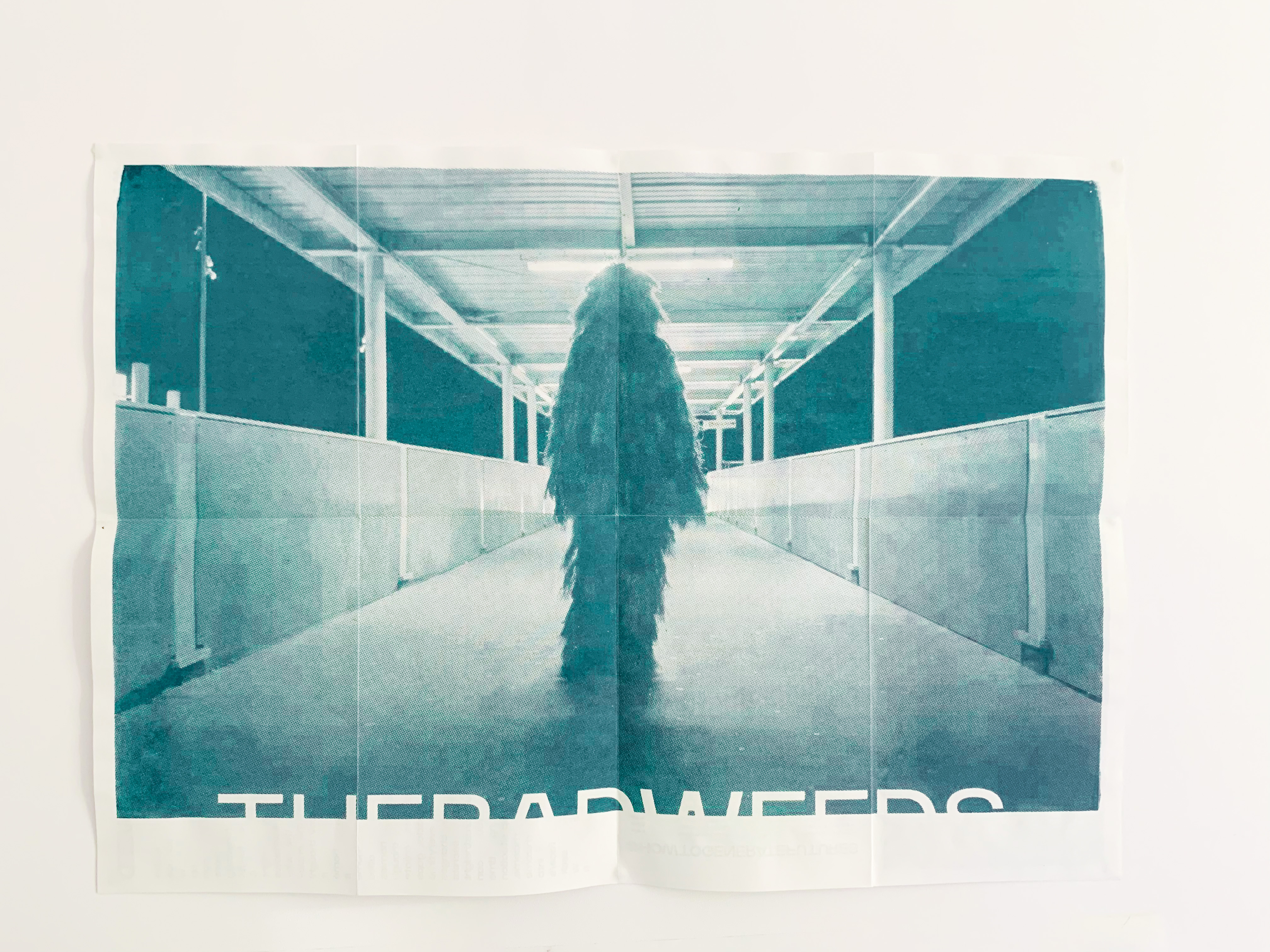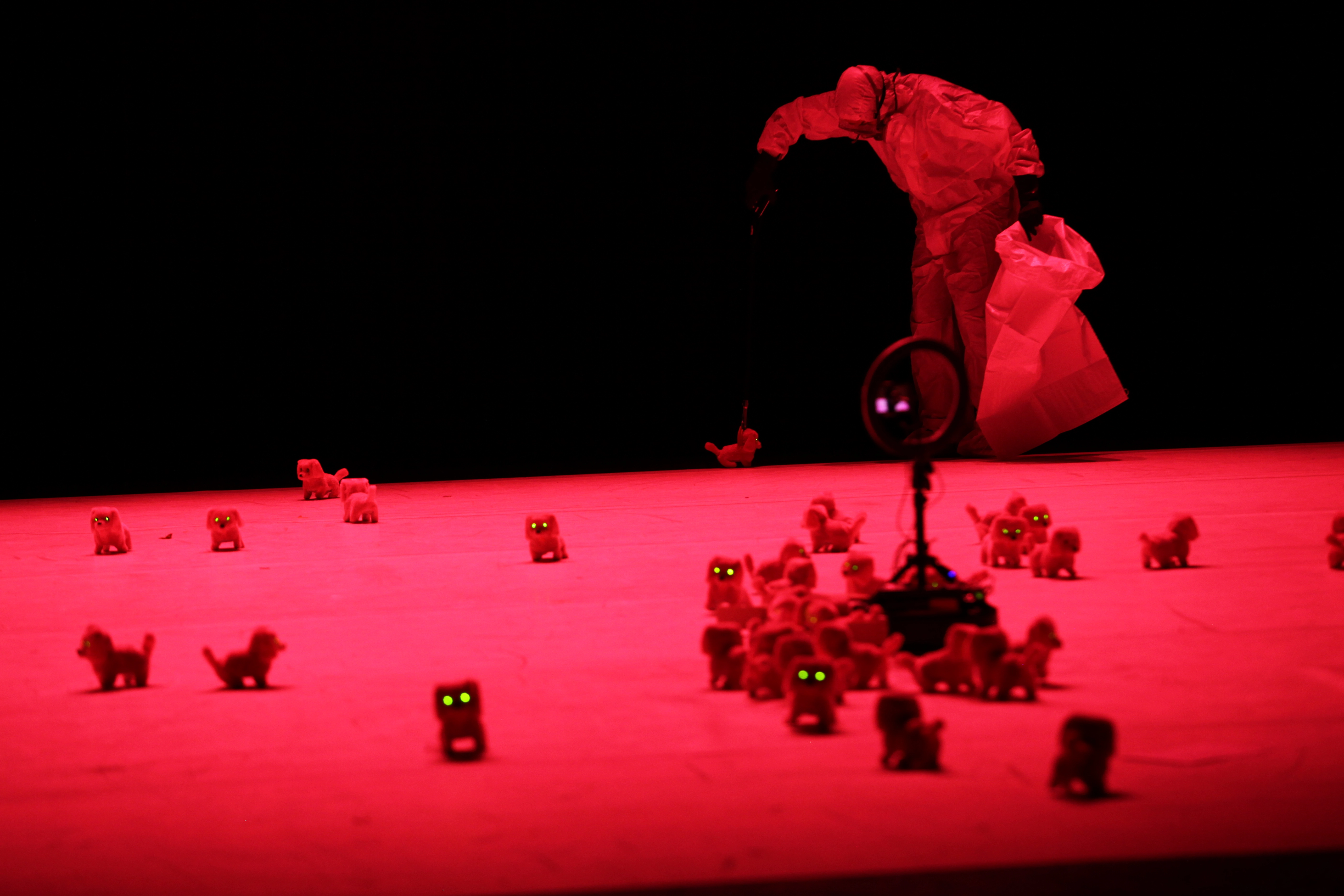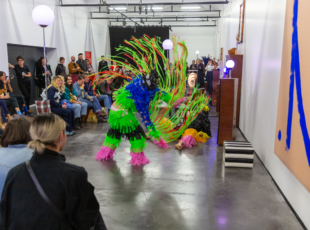Rocio Berenguer, an indisciplinary artist

Article author :
Often disconcerting, Rocio Berenguer’s shows explore the theme of the living world. Mixing dance, digital devices, theatre and writing, Rocio Berenguer is simultaneously a multifaceted and rebellious author. A portrait of this ‘indisciplinary’ artist.
Rocio Berenguer’s work projects the issues of our contemporary world – the development of spaces of individual freedom, the role of technologies in our daily lives, the ecological urgency – into hypothetical futures. In her most recent show, THEBADWEEDS, created in 2023, Rocio Berenguer imagines a half-human, half-plant music band. On the stage, bizarre green and shaggy-haired creatures sing, slam and dance in a trans-species world. The bodies of these beings are covered in vegetation and are nourished by means of a kind of photosynthesis whose energy source is the sun. That in itself offers an idea of the free and off-the-wall spirit of the Spanish artist. ‘THEBADWEEDS is a punk show. In it I stand by my humour and joy. For this performance, I wanted to reach out to a very wide audience from every type of background… I mixed several languages (Editor’s note: English, French, Spanish) for the most inclusive message possible,’ explains Rocio Berenguer, who conceives her works in her Paris studio or in different partner laboratories. ‘I adore working on multiple collaborations with specialists and scientists. I have the good fortune that they frequently respond to my questions. They are extremely generous people who offer me a part of their time, their knowledge. It is one of the aspects of my profession I prefer. Then, with the accumulation of knowledge, I attempt to create my own viewpoint on things. The aim is to construct a form which is as expressive as possible.’

The body, the city, the living world…
Whilst this claim is pregnant, it is because the theme the artist explores, that of the living world and its corollaries, lends itself very well to it. For around ten years or so, the artist has probed the notions of the body, nature and the city. ‘We live in a culture which dissociates object and subject. Worse still, the living world tends to become an object to be exploited. How pretentious to believe the human being is the most evolved life form on Earth. Our environment has urbanised, it has become sterile. I believe that we need to urgently question our relationship with the world.’ And the way Rocio Berenguer has chosen to interrogate us is to adopt a prospective vision. Possible futures, desirable or otherwise. ‘Offering a glimpse of the future gives people a sense of responsibility concerning the actions they take today. The prospective is a very powerful lever of emancipation.’ To carry this out, the artist has no hesitation in taking advantage of and hijacking technologies such as the conversational agents (chatbots) that are to be found in several of her shows and installations.
Homoeostasis (2016), a flamenco-contemporary dance show, thereby formalises her corpus of works. On the stage a woman initiates a dialogue with a computer. She would like to reprogramme her internal structure and achieve an upgraded version of herself. Computer bugs and flamenco cadences begin to interfere with the dialogue between the various elements of the system: dance, video, speech. In Homoeostasis, the body – either as a subject or an object – again establishes itself as a central theme. What is the value of the unique, chance, poetry, the body? What place for the random, the accidental? How to integrate error as a committed position, as a communication protocol between body and machine? Questions which are especially current in view of the debates surrounding the creative potential of generative artificial intelligences such as ChatGPT and Midjourney. For all that, the artist defends herself against accusations of any opportunism: ‘I don’t have any interest in current affairs in themselves. Then again, I need to understand the movement of the world. My thoughts belong to the world I find myself immersed in.’
Ergonomics (2018), a danced lecture in which the audience actively takes part in the choreography, goes further still in the objectivation of the body. This choreographic fiction is inspired by marketing strategies and hijacks the ‘disruptive’ discourse of start-ups. The show’s guiding question – what adaptations and what uses of the body must be considered for a smart city of the future? – allows Rocio Berenguer to explore in quirky ways the contemporary themes of the future body, the urban body, the Smart City and the clichés of innovation. ‘For this show, I didn’t set out to please, but to disturb. What notions do we have of our bodies? What are the directives which make possible a mechanical and utilitarian view of our bodies? Ergonomics is a fiction on the absolute instrumentalisation of the body, on our capacity to make it become an object. Ergonomics is a project which dates back to 2018. Today, it is perhaps too close to reality. When fiction finally becomes the norm, it is terrifying.’

Radical otherness
For a few months now, Rocio Berenguer has seemed to be opening a new chapter in her work: ‘I am interested in radical otherness. By that I mean the relationships between bodies and other forms of body. How to understand the difference of the other? What is the intelligible limit to otherness?’ THEBADWEEDS (2023), mentioned earlier, is fully in keeping with this field of study. But it is above all G5 (2020) which marked a turning point in the search for radical otherness. In this project, Rocio Berenguer imagines an interspecies meeting at which the various realms of the living world are invited to negotiate together the possibilities of their coexistence. G5, an ironic reference to the G8 and G20 type of political summit, brings together the different species which share the globe – animal, mineral, vegetable, human, machine – to debate the planet’s future. This project offers a possible scenario of our future and opens up avenues for the utopias which remain to be constructed by us. For example, accepting the status of subjects and recognising a legal personality for non-human living beings could be a means of considering and respecting the other forms of life on Earth. G5 also comprises two additional sections. A performance section, Coexistence, in which a poem is slammed to music co-written with a machine. An installation section, Lithosys, which presents an interspecies communication system mixing mineral and machine intelligence. ‘My next creation will continue exploring the same themes as G5 and this investigation of radical otherness. I want to express my utopian vision.’ A vision you will be able to discover during the 2023 tour which will include several European cities.

A story, projects or an idea to share?
Suggest your content on kingkong.





